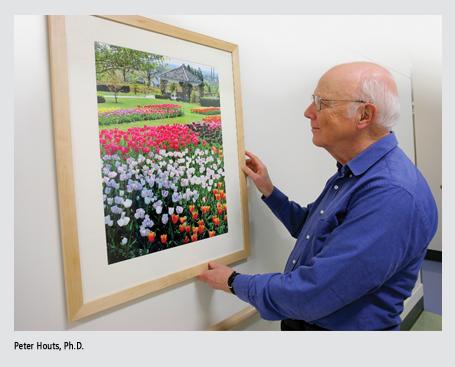Filling the halls with beauty
With an artistic eye and a knack for photography, Peter Houts, PhD, brought the beauty and splendor of the Hershey Gardens into the halls of the new Penn State Hershey Cancer Institute when he generously donated several of his landscape photographs. Each photograph displayed in the Cancer Institute, whether it captures the garden’s famous tulips and roses, a light crisp snowfall, or a path in the perennials garden, conveys a world full of color, imagination, and peace.
The opportunity to photograph the renowned Hershey Gardens came when his wife, Mary Davidoff Houts, was presented with the project of writing a book about the history of the gardens. The project needed a photographer and Houts enthusiastically accepted the position. The book, Hershey Gardens: The Cornfield that Blossomed with Roses, contains many photographs, half of which Houts took.
But his passion for photography bloomed long before that opportunity. It all began shortly after World War II when Houts was thirteen and he bought his first camera. He soon plunged into a world full of captured images and dark rooms. “The magic of seeing a picture come out of the developer in the dark room was so intriguing as a child,” remembers Houts. He experienced the evolution of photography from the dark room to the digitally captured picture. Houts said, “As a result of that I do more photography and I just love it.”
After Houts retired in 1998, he continued to pursue his love of photography by attending art school for graphic design. Through his studies and personal experience Houts learned that the key idea or goal of photography is to draw people into the picture and have them search it. If the picture is successful, a person will want to stand there, look at it, and study it instead of just glancing at it. So with each photograph, Houts provides viewers a personal invitation to step into his creation and experience life, nature, and beauty.
 When Houts heard that the Cancer Institute was being built and the planning committee was searching for pictures to display, he quickly stepped forward. “I told them that I would be happy to offer some, and so one thing led to another,” Houts said.
When Houts heard that the Cancer Institute was being built and the planning committee was searching for pictures to display, he quickly stepped forward. “I told them that I would be happy to offer some, and so one thing led to another,” Houts said.
Although donating his photographs was important to him, Houts also holds the Cancer Institute close to his heart. “I decided to give some of my photos to the Cancer Institute because so much of my professional career was involved with cancer,” said Houts. “I am so appreciative I can have them in a place where people can see them and enjoy them, and that’s the reward for me.”
Much of Houts’ involvement with the Cancer Institute relates to the research on cancer he conducted back in 1980 at the Medical Center. As a social psychologist, he assessed the problems and needs that cancer patients, their families, and their care givers experienced when coping with illness. The findings of his studies helped to improve the life, care, and experience of the patients and their families. The Cancer Institute not only has Houts’ collection of photographs, but also his lasting legacy of dedication and hope.
– By Catherine Duckworth
If you're having trouble accessing this content, or would like it in another format, please email the Penn State College of Medicine web department.
